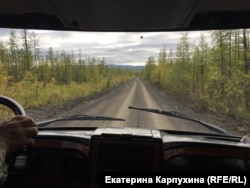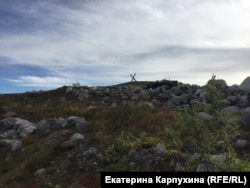YAKUTSK, Russia -- No one knows where the bones of the victims of dictator Josef Stalin's gulag in the Far Eastern region of Sakha (formerly Yakutia) are buried. But the bones of the camps themselves still litter the most remote and inhospitable corners of the vast territory.
During Stalin's reign of terror, there were no less than 105 gulag camps in Sakha, covering about one-third of its area. Even today, it is nearly impossible to reach some of the most far-flung locations -- places like Tomponsky, Oimyakonsky, and Verkhoyansky -- where prisoners worked and died by the tens of thousands.
"We are talking about hundreds and thousands of kilometers just to get to these places -- mostly without roads in the most inhuman circumstances," geologist Arkady Vishnevsky wrote in his memoirs. "We can only guess how many people died on the way there, never even reaching the place where they were supposed to serve their sentences."
"The ones who did arrive were given the most difficult physical labor -- in mines, in construction, laying roads, breaking rocks, felling trees," he continued. "They worked in brigades of 30 to 40 people under armed guard. Every morning, after roll call, they went out to work and in the evening, after being frisked, they found themselves once again behind the barbed wire. Not many survived their full sentences from beginning to end. It is hard for me to think that the village of Batagai, where I lived and worked, largely came into being through the work of the slaves of Stalin's camps."
This summer, a small group of enthusiasts made the arduous, 64-kilometer journey from Batagai to 1,271-meter Mt. Kyoster, which was once the location of the Yansky labor camps.
"From tsarist times, our Verkhoyansky region was a place of political exile," local management specialist Dmitry Gabyshev told RFE/RL during the expedition in late August. "And in Soviet times, they mined here using prisoner labor. It was a prison without bars since there are only hills as far as you can see. Even if you really wanted to and made a tremendous effort, it was impossible to run off and survive. Our expedition is dedicated to the eternal memory of the prisoners of the Yansky camp system, so that we -- today's young people -- remember and understand at what price our lives were built."
In 1937, Soviet geologist Porfiry Yepifanov discovered deposits of tin and rare-earth minerals on Mount Kyoster in northeastern Sakha. Stalin's NKVD security police took over the area in 1940, eventually building 22 camps in the Yansky system. It is said that Stalin himself determined the placement of the arrow-straight road from the Kyoster mines to Batagai, where a processing plant was built.
Today, the road is difficult to traverse, uneven and once again partially overtaken by the surrounding forest. It serpentines its way to the top of the mountain -- a desolate, abandoned place now with endless fields of the rocks that once were valued more dearly than human lives.
Russia this year is quietly marking the 100th anniversary of the 1917 Bolshevik coup that created the Soviet Union and the 80th anniversary of 1937, the peak of Stalin's brutal Great Terror. One aspect of Stalin's sprawling gulag system that is particularly relevant in mineral- and diamond-rich Sakha is its economic importance. Although primarily a system of terrorizing the Soviet populace, the labor camps shaped and defined key parts of the economic landscape.
"The gulag actually had the task of digging coal mines, of digging uranium mines, gold mines," Pulitzer Prize-winning historian Anne Applebaum told RFE/RL in a 2013 interview. "It was an enormous economic empire, controlling factories and whole areas of Russia. Northeast Russia was settled by the gulag -- prisoners and guards. Some of the Far Northern cities were effectively built by the gulag -- Vorkuta, Norilsk, cities like that."
"The camps of the gulag are a terrifying echo of the totalitarian system of the Soviet state," Gabyshev said.
The Yansky prisoners came to this mountain via the port city of Magadan. There they were transferred to smaller ships and taken to the mouth of the Yana River, where barges waited to take them up to Batagai. From there, for the most part, they walked the remaining kilometers to their work camps in the mountains and forests.
Much about their lives in the Yansky camps remains unknown, locked up in archives sealed by the Russian government.
"The topic of the Yansky camps remains completely closed," local historian Pavel Kazaryan told RFE/RL. "We know nothing about the number of prisoners, their names, their personal lives. All that information from the Soviet period, for well-known reasons, has been labeled secret. Today, the documents are in Magadan, since the Yansky camps were part of Dalstroi (the Far Eastern economic unit of the NKVD). We can access information about the economic activity of various enterprises, but there is nothing about the prisoners. You need special permission to see those documents."
The summit of Kyoster is absolutely silent. The first thing one notices is not the endless expanse of forest stretching from horizon to horizon but rather the nearby lunar landscape of rocks the prisoners brought up from the mine and then broke into bits day by day with picks. Among the stones, in a wreath of barbed wire, there is a small memorial plaque to the victims of Yansky with the simple plea, "Forgive us."
"This summer, I am coming to Mt. Kyoster for the first time," said Yegor Starostin, a 19-year-old resident of Batagai. "I've wanted to come for a long time but not every car can make that trip. I managed to get here only this year."
"The air here is very heavy and it is hard for me to breathe," he continued. "As if the very place is pressing on me. All these empty barrels, ruined structures, the former mines, and -- everywhere -- those stones. I can't imagine how people lived and worked here. In school, they told us a little about the camps and the prisoners, but it is completely different when you see it with your own eyes. History is here before your very eyes. It is a very somber place."
Some 650 kilometers to the southwest lies the regional capital, Yakutsk. In the center of Yakutsk, there is a shining bronze bust of Stalin, erected by local communists and World War II veterans in 2013. It is actually the second monument to the dictator in Sakha, after one was erected in the town of Mirny in 2005.
Nikolai Gabyshev is a 29-year-old telecommunications worker who lives in Yakutsk. He has been to Batagai and recalls his father telling him about the camps and the prisoners who died in Sakha. Nonetheless, his attitude toward Stalin is ambiguous.
"I saw how the local communists were collecting signatures in support of the monument for Stalin," he told RFE/RL. "I can't say much about him, either positive or negative. I am neutral on Stalin. I know that he has a bust in Yakutsk, and I am in favor of historical monuments. We have to know the history of our county -- and I'm not against that."
In late 1953, the Soviet government issued a general amnesty and the prisoners began to leave. Today, there are very few relatives of former prisoners in Batagai -- the few prisoners who stayed tended to live short and solitary lives. By 1957, the mines and the processing plant were closed, economically unviable without the infusion of slave labor.
Local resident Natalya Zhukova recalls how in the late 1950s she and other children spent parts of their summers at a recreation camp that was formerly part of the gulag.
"You could still see bits of the camps then, since the repressions and the labor camps were only wound up in 1957," she told RFE/RL. "In the Yuttyakh children's camp, we vacationed every summer. Our parents got vouchers through their trade unions. It wasn't easy to get one. Only later I understood that Yuttyakh used to be a place for prisoners, mostly those sentenced under the badly abused Article 58 (treason, sabotage, anti-Soviet activity)."











